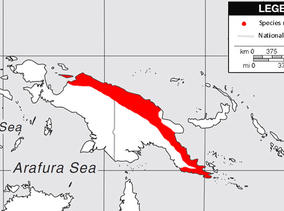You are here
Species
Megapodiidae
Nomenclature
-
Order: Galliformes
SUMMARY
Megapodes are medium to large chicken-like birds with large feet. Adult body measurements are variable, from 50 cm to 70 cm in length and 275 g to 2950 g in weight. Megapodes are generally brown to black in color. Some species have a prominent head casque, wattles or bare heads and necks with brightly colored skin. Most species are sexually monomorphic in appearance, although one is dimorphic in size (females smaller), coloration (females less brightly colored) and wattles (female wattles absent). Upon hatching, chicks are covered with brown or buffy feathers (not down). Weight at hatching is variable, perhaps ranging from 80 g to 173 g. (Campbell and Lack, 1985; Jones, Dekker, and Roselaar, 1995)
Most megapodes are described as monogamous, although some species probably exhibit polygynandry. Monogamous pairs appear to form social bonds that may continue outside of the breeding season. Males generally compete for and defend incubation sites or females. Some species congregate regularly to roost. Species that use clumped geothermal incubation sites may aggregate in large numbers (over 50,000) onto communal incubation sites.Megapodius spp., Eulipoa wallacei, and perhaps Talegalla are thought to exhibit female-defense monogamy. Males appear to defend a single female. The process of mate selection and pair formation is not known. The pairs stay in close proximity, exhibit behavioral synchrony, and locate and maintain incubation sites together. Pairs avoid other pairs through loud vocalizations. Mallee fowl are considered to exhibit resource-defense monogamy. Pair bonds are evident for part of the breeding season. Males alone compete aggressively for mound sites. During construction of the incubation mound a pair works together, but once egg laying begins the male and female appear to become independent of one another. Brush-turkeys (Aepydius) are thought to exhibit resource-defense polygynandry. Males defend incubation sites. The sexes interact only when females visit incubation mounds to copulate and to lay eggs. Females may lay eggs for multiple males. Males alone compete for, maintain and defend incubation mounds. Males and females may copulate with multiple mates. (Campbell and Lack, 1985; Jones, Dekker, and Roselaar, 1995; Payne, 2000). The length of the breeding season is variable. The beginning of the construction of incubation sites appears to be related to local climactic conditions. In some species the beginning of incubation site construction coincides with the onset of the rainy season and in others it coincides with the onset of the dry season.Females may lay from 3 to 35 eggs over the course of the breeding season. The egg-laying interval may be 2 to 13 days and may occur over periods ranging from 2 to 4 months. Megapode eggs are generally white or creamy in color. Eggs are large and variable in size depending on species (weights range from 75 to 230 g). Incubation period appears to be dependent on the temperature in the mound or burrow. The average duration may range from 44 to 77 days. Megapode chicks are precocial. Chicks may hatch from 20 cm to 1 m below the surface of the mound. The time it takes for chicks to reach the surface is variable, but may range from 2 to 60 hours. Digging out of the mound is thought to entail chicks lying on their backs and scraping the material with their feet, then compressing the falling material with their backs. Chicks dig out from the mound without direct parental assistance. Upon emergence chicks have functional flight feathers, can walk and run, and commence foraging independently. Little is known about the foraging abilities of newly emergent chicks. No parental care of emergent chicks has been observed. Age of maturity is not well known, but may be achieved in 1 to 3 years. (Campbell and Lack, 1985; Jones, Dekker, and Roselaar, 1995).
Megapodes are mainly terrestrial ground dwelling birds that move about mostly by walking. Some species fly frequently while others fly mainly to roost in trees or to escape predation. They are sedentary and generally do not migrate. Brush turkeys and mallee fowl are largely solitary whereas other species appear to live in pairs. Some megapodes congregate and roost in large numbers. Mound construction entails digging and scraping with the feet and toes, and the collection and mixing of organic materials. Construction of the incubation mound may be done by the male alone or jointly by the mated pair. Male and female megapodes have been observed to monitor the temperature of the incubation chamber. The head is inserted into a previously excavated chamber that leads to the core of the mound. Females generally check the temperature of a mound just prior to laying. Males often monitor temperature during the incubation period. Intra- and inter-sexual conflicts occur in conjunction with competition for resources (incubation sites, females, food items). Aggressive interactions include chases, pecks, threat displays and wing-blows. Submission appears to include a drawing in of the neck and movement away from dominant bird. Chicks appear to avoid one another during the first weeks after emergence. If chicks do meet, the interactions are often agonistic. (Jones, Dekker, and Roselaar, 1995).
Megapodes are omnivores, known to eat plant material, invertebrates and small vertebrates. The plant material they eat includes: seeds, fruits, berries, various sprouts/shoots, foliage and flowers. Invertebrates consumed include: termites, ants, cockroaches, grasshoppers, dragonflies, spiders, wasps, centipedes, snails, worms, small crabs. Small vertebrates include frogs and small lizards. (Campbell and Lack, 1985; Jones, Dekker, and Roselaar, 1995)
Megapodes inhabit a diversity of forest types (wet, dry, humid, swamp, gallery, monsoon) in lowland and highland regions. Some species occupy scrub forests, urban areas, and semi-arid habitats. (Campbell and Lack, 1985; Jones, Dekker, and Roselaar, 1995)






